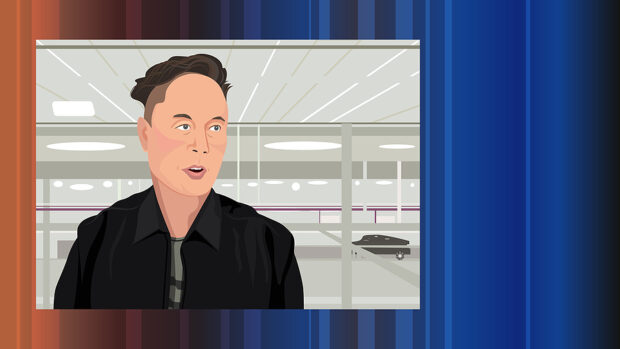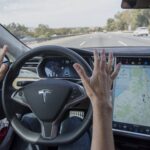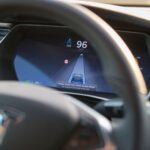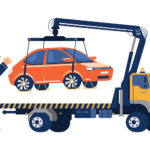While executives of Tesla said the car maker’s insurance business isn’t yet big enough to warrant separate financial disclosure of its results, Chief Executive Officer Elon Musk reiterated a benefit for Tesla owners: cheaper premiums.
Speaking on an earnings conference call Wednesday, Musk said that “just by Tesla operating insurance for our cars at a competitive rate, that makes the other car insurance companies offer better rates for Teslas.” In other words, Tesla being in the insurance business “has a bigger effect than you think” because it lowers the cost of insurance even for Tesla drivers who don’t buy insurance coverage from Tesla. That’s because “now the GEICOs of the world have to compete with Tesla and cannot charge outrageous insurance for Teslas,” Musk asserted.
“It has an amplified effect, [which is] very important,” he said.
Musk went on to reiterate a second benefit which he has also described on past earnings calls: the creation of “a good feedback loop into minimizing the cost of repair of Teslas” as Tesla handles insurance claims. “We obviously want to minimize the cost of repairing a Tesla if it’s in a collision” for the customer and for Tesla Insurance. “Previously, we didn’t actually have good insight into that because the other insurance companies would cover the cost. And actually, the costs in some cases were unreasonably high,” he said.
Related article: Tesla Insurance Turning ‘Nightmare’ Claims Experience Into ‘Dream’: Musk
Now, with insight into damages caused by small accidents, “we’ve actually adjusted the design of the car and made changes in the software of the car to minimize the cost of repair… We’re actually solving how to get somebody’s car repaired very quickly and efficiently and back in their hands,” he said, noting that most accidents are actually small—”like a broken fender or scratched side of the car”—but provide this valuable feedback to build upon.
The design improvements made from the feedback “actually apply then to all cars…It’s remarkable how small changes in design of the bumper and obviously improving the logistics of providing spare parts needed for collision repair have an enormous effect on the repair cost.”
“If you’re waiting for a part to get repaired and that part takes a month, now you’ve got a month of having to rent another car. It’s extremely expensive. And, of course, you’re missing the car that you love and the one you actually want to drive. So, this has actually a very significant effect on total cost of ownership and customer happiness,” he said, describing the second key benefit of Tesla being in the business of insurance.
(Editor’s Note: Separately, Reuters reported this week that a Reuters analysis shows that traditional insurers are likely to total low-mileage Teslas rather than paying for repairs.)
He added: “The best repair is no repair, avoid the accident entirely, which since every Tesla comes with the most advanced active safety in the world, whether or not you buy full self-driving, you still get the intelligence of full self-driving for active collision prevention.”
Musk’s discussion of insurance came after Chief Financial Officer Zach Kirkhorn addressed a question about potential timing for disclosure of Tesla Insurance results along with result of Tesla’s vehicle, energy and stationary storage businesses. Asked when he thought insurance would grow to be a big enough revenue source to warrant providing more details in the financials, Kirkhorn said it would take some time. He did, however, shed some light on just how big the business is today.
“We’re currently at a $300 million annual premium run rate as of the end of last year. We’re growing 20 percent a quarter”—a growth rate that exceeds the growth of Tesla’s vehicle business. In addition, he said that 17 percent of Tesla drivers opt to buy Tesla Insurance in states it’s available. “And that number continues to tick up as we spend more time in markets.”
Kirkhorn added, “We see most of the adoption occurring when folks take delivery of a new car, as they’re setting up insurance for the first time as opposed to going back and switching when they already have insurance set up. So, there’s an inherent stickiness in the insurance business.”
Concluding his remarks, Kirkhorn introduced the idea of a pricing benefit, which Musk then expanded upon. “The motivation for starting this business…was to improve and still is to improve the total cost of ownership of our cars given that we’re seeing high premiums of insurance from third-party companies. And that remains our priority here.”
“We’ll obviously run this as a healthy business, but we want to make sure we keep our costs low and insurance stays affordable to our customers,” Kirkhorn said.
The affordability issue came up during the earnings call when Musk was addressing questions about price cuts in Tesla cars themselves. “Basically, price really matters. I think there’s just a vast number of people that want to buy a Tesla car but can’t afford it… Price changes really make a difference for the average consumer. And sometimes people who are well off—who have a lot of money, they sort of forget about how important affordability is.”
“It’s always been our goal at Tesla to make cars that are affordable to as many people as possible, so I’m glad that we’re able to do so,” Musk said.
The CEO made those statements during his opening remarks as he voluntarily addressed concerns he believes are on investors’ minds about demand for Tesla vehicles. “I want to put that concern to rest. Thus far in January, we’ve seen the strongest orders year-to-date than ever in our history. We currently are seeing orders at almost twice the rate of production. It’s hard to say whether that will continue at twice the rate of production, but the orders are high. And we’ve actually raised the Model Y price a little bit in response to that,” he said.
Like personal lines insurance financial leaders, Kirkhorn devoted part of his opening remarks to the impacts of supply chain disruptions and inflation in materials costs on the vehicle and battery cell production businesses, as well as efforts being made to address production inefficiencies. But Kirkhorn said that Tesla is taking a long-term view on vehicle pricing.
“We’re holding steady on our plans to rapidly increase volume while improving overhead efficiency, which is the most effective method to retain strength in our operating margins,” he said. In addition to addressing particular factory locations where inefficiencies are particularly high, he said, “we are attacking every other area of cost and unwinding cost increases created for multiple years of COVID-related instability…”
“As the world transitions from an inflationary to deflationary environment, we expect a strong partnership with our suppliers on this journey as well in that we’ve priced our products with a view toward a longer-term cost structure. Thus, there will be an impact on operating margin in the near term. However, we believe our margins will remain healthy and industry-leading over the course of the year.”
In other opening comments that might be of interest to insurers of Teslas or of other vehicles on the road alongside Teslas, Musk revealed that Tesla has deployed Full Self-Driving Beta for city streets to roughly 400,000 North American customers. “This is a huge milestone for autonomy as FSD Beta is the only way any consumer can actually test the latest AI-powered autonomy.”
“We would not have released the FSD Beta if the safety statistics were not excellent,” he said, noting that the statistics now encompass roughly 100 million miles of FSD outside of highways.
Kirkhorn and Musk also said that production of Tesla’s Cybertruck is expected to begin this summer—sort of.
“But I always like to try to downplay the start of production because the start of production is always very slow. It increases exponentially, but it’s always very slow at first. So, I wouldn’t put too much stock in start of production. It’s kind of when does volume production actually happen, and that’s next year,” Musk said.





















 Good Times for U.S. P/C Insurers May Not Last; Auto Challenges Ahead
Good Times for U.S. P/C Insurers May Not Last; Auto Challenges Ahead  Slideshow: Carrier Management’s 2025 Top Editor’s Picks (Unlocked)
Slideshow: Carrier Management’s 2025 Top Editor’s Picks (Unlocked)  First Atlantic Hurricane Forecast for 2026 Suggests Season Close to 30-Year Norm
First Atlantic Hurricane Forecast for 2026 Suggests Season Close to 30-Year Norm  What to Expect in 2026: U.S. P/C Results More Like 2024
What to Expect in 2026: U.S. P/C Results More Like 2024 






